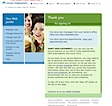Janet HealthConnect is not a real person – she’s a manufactured patient that exists in a test version of Kaiser Permanente’s HealthConnect electronic health record. She’s coming with myself and Anna-Lisa Silvestre, Vice President of Online Services for Kaiser Permanente to demonstrate the integration between personal health record, electronic health record, and health care delivery at the “Health 2.0 Meets Ix” conference in Boston, next week.
Myself and colleagues at Kaiser Permanente are putting together a live demo of the systems with a twist – nothing is going to be live.
Janet’s My Health Manager on kp.org experience is going to be demonstrated using a series of HTML pages that have been saved from a running instance of a test version kp.org and manipulated by hand.
Janet’s doctor’s experience using the KP HealthConnect electronic health record is going to be demonstrated using a screen movie, filmed from a running instance of a test version of the electronic health record.
It used to be that “nothing substituted for live” in the area of information technology demonstrations; now, however we’ve come full circle.
Why?
- Protection of members’ information – Because KP HealthConnect is fully operational across the nation, no connections to the production system can be made outside of the places where they need to be made – to support delivery of care. This is the only reason to connect to the production system.
- Integrated care delivery is impressive, and complex – Kaiser Permanente’s strength as a system, its ability to coordinate health care across clinical specialties, time, and space, makes it nearly impossible to create a functional test “sandbox” that is working for every purpose, every time, the same way its production systems are tuned. Test systems may not be powered to function at the speed of production system, or may not be linked to a test copy of every system used to integrate care. There is never a question about where the power of systems should be directed – it is to taking care of members.
- The goal is to demonstrate what a functional system does for patients, not the speed of an internet connection in a conference room – We have all seen demonstrations where the message was lost on the audience due to unforseen technical problems. It’s inappropriate to use a hotel’s internet connection to simulate the approach to connectivity that exists in a modern medical office. Very different purposes.
- Live demo doesn’t differentiate “hype” from “reality” in this case – As I’ve shown on this blog and in 421 medical offices across the United States, live systems are supporting members every day. My Health Manager just surpassed 2.9 million active users across the United States, to boot.
It has taken even me some time to recognize (with the help of colleagues at KP – thank you!) that the benefit of doing things live for an external audience brings unacceptable costs.
All of this said, even a scripted demonstration based on live systems is going to have some plot holes, like why wasn’t a certain lab done for a certain indication on this patient? For those of you in attendance next week, feel free to let me know which ones you spot…

1 Comment
Ted,
Sorry I couldn't come to the conference. Hopefully your presentation will be available on youtube.